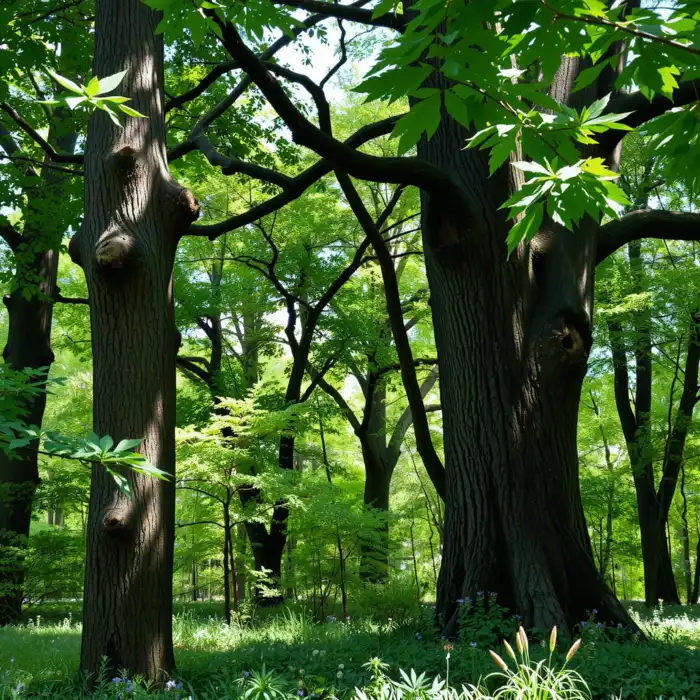Environmental Benefits
Native trees support biodiversity and reduce chemical usage, contributing significantly to ecosystem health.
2025-06-08
Have you considered how your local trees contribute to the ecosystem? Native trees are not just beautiful; they are essential for a thriving environment. Let's explore the significance of these trees and why they deserve a place in our gardens and communities.
Understanding the essential benefits of native trees reinforces their value in maintaining healthy ecosystems.
Native trees support biodiversity and reduce chemical usage, contributing significantly to ecosystem health.
They provide food and habitat for a variety of local species, enhancing ecological balance.
Native trees typically require less care, making them cost-effective and sustainable.
Adaptation to local climates and soils increases their survival and growth rates.
Less dependency on chemical treatments leads to significant financial savings for gardeners.
Reduced maintenance means more time to enjoy nature and a beautiful garden.
Have you ever paused to admire a local tree and wondered how it fits into our environment? Native trees are like the heartbeats of ecosystems, playing crucial roles in supporting wildlife, enhancing soil health, and maintaining our natural landscapes. At Deep Roots Journal, I am passionate about revealing how these trees not only survive but thrive in their home environments, showcasing their vital importance.
So, what exactly are native trees? They are species that have evolved in a specific region over thousands of years, adapting to the local climate, soil, and ecosystems. This close relationship allows them to support a diverse array of wildlife, contribute to soil health, and withstand local pests and diseases. By choosing to plant native trees, we foster a more resilient and balanced environment.
Native trees are essential to maintaining the balance of their ecosystems. They provide vital habitat and food resources for local fauna, including birds, mammals, and insects. Their deep root systems also play a significant role in improving soil structure and water retention, which is pivotal for ecosystem health. For further insights into essential tree care, understanding these interactions is key.
When we think about planting trees, it’s important to consider the profound impact on our local wildlife. Native trees support species that have co-evolved with them, meaning their existence is intricately linked. For instance, oaks provide food for over 500 species of caterpillars, which are vital for birds and other wildlife. This interdependence highlights the importance of native trees in creating vibrant, thriving ecosystems.
Now that we understand what native trees are, let’s explore some key reasons to prioritize planting them. First and foremost, they are naturally adapted to thrive in your local area, requiring less water, fewer fertilizers, and minimal maintenance compared to non-native species. This adaptability not only saves you time but also promotes a sustainable gardening approach.
Additionally, planting native trees supports biodiversity. When we choose native species for our yards and communities, we create habitats that encourage wildlife to flourish. Imagine walking through a park filled with trees that are buzzing with activity—every rustle of leaves is a reminder of the life they support. This vibrant community of flora and fauna is essential for the health of our ecosystems.
At Deep Roots Journal, I am dedicated to spreading the word about the importance of native trees. By focusing on these species, we can create environments that not only look beautiful but also sustain the intricate web of life that surrounds us. Let’s embrace the beauty and benefits of native trees in our gardens and communities!
Have you ever considered how the trees in your neighborhood impact your daily life? Think about the last time you took a walk in a park or your backyard:
We'd love to hear your thoughts! Share your experiences with native trees in the comments below!
Planting native tree species provides a myriad of advantages that extend beyond aesthetics. These trees not only contribute to environmental health but also support local wildlife and enhance the overall resilience of our ecosystems. As we reflect on the key benefits, it becomes increasingly clear why native trees should be at the forefront of our planting choices.
One of the most significant advantages includes the environmental benefits that native trees offer. They help conserve water, reduce the need for chemical applications, and play a crucial role in mitigating climate change. These trees are adapted to local conditions, making them essential for maintaining the delicate balance of our ecosystems.
Low maintenance is often an appealing aspect of planting native trees. Because these trees are well-suited to their local environments, they typically require less watering and fewer fertilizers compared to non-native species. This adaptability not only makes them easier to care for but also helps conserve valuable resources. For advice on encouraging healthy root development, which contributes to low maintenance, consider native species.
Choosing native species can lead to long-term cost savings. For instance, by planting trees that thrive naturally in your area, you’re less likely to need expensive interventions like chemical pesticides or extensive irrigation systems. At Deep Roots Journal, we've seen how community gardens filled with native trees flourish with minimal upkeep, allowing gardeners to enjoy the beauty of nature without the stress of high maintenance.
Curious about selecting the right trees for your garden? Understanding your local climate and soil conditions is key to ensuring the health and longevity of your trees.
In conclusion, focusing on native tree species isn’t just a trend; it’s a commitment to fostering healthier ecosystems. By planting these trees, we not only enhance our immediate environment but also pave the way for future generations to appreciate the beauty and benefits of the natural world. Let’s make the choice to plant native today for a greener tomorrow!
Here is a quick recap of the important points discussed in the article:
